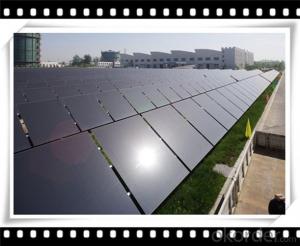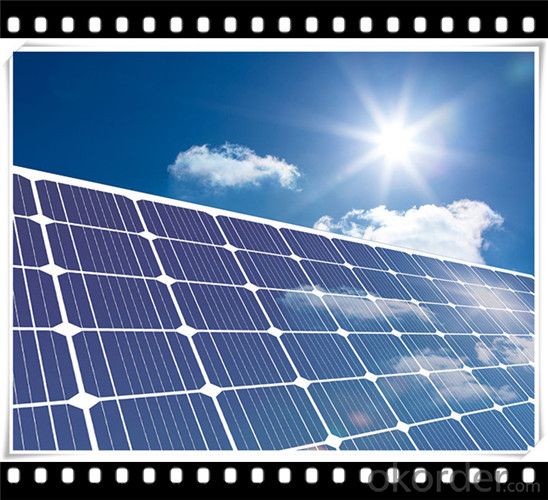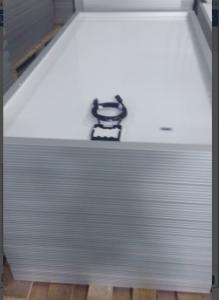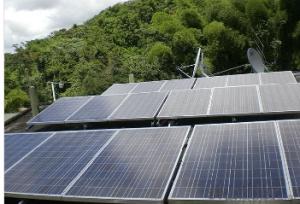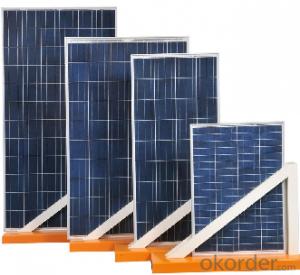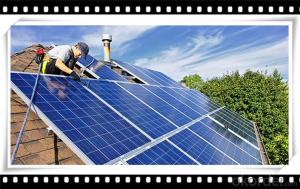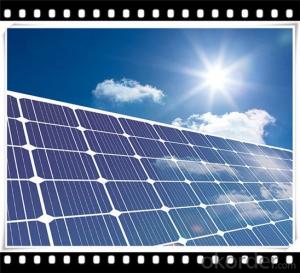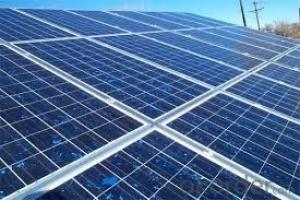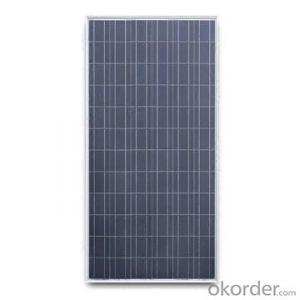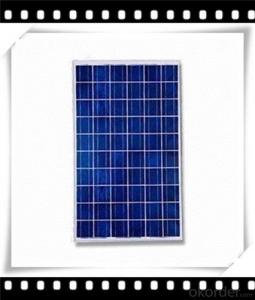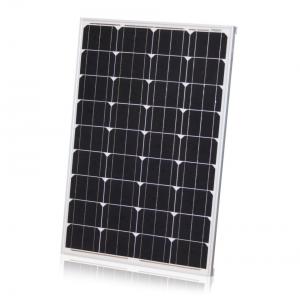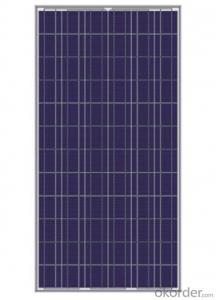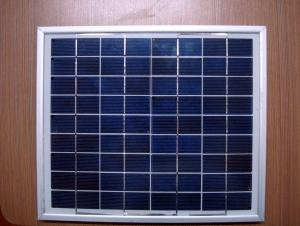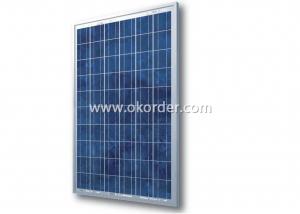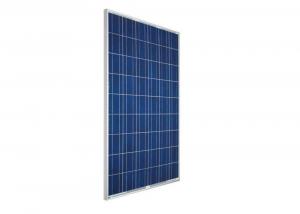70W Small Camping Solar Panels - Poly Solar Panel Manufacturer in China CNBM
- Loading Port:
- Qingdao
- Payment Terms:
- TT OR LC
- Min Order Qty:
- 10 set
- Supply Capability:
- 300000 set/month
OKorder Service Pledge
OKorder Financial Service
You Might Also Like
Polycrystalline Solar Modules
CNBM offers a range of small, medium and large polycrystalline solar modules, designed for a range of requirements.
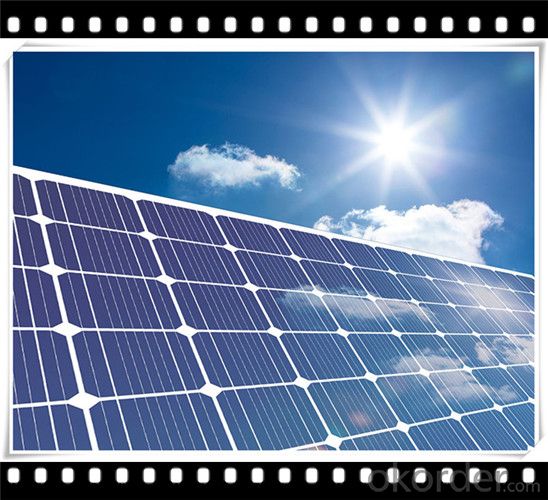
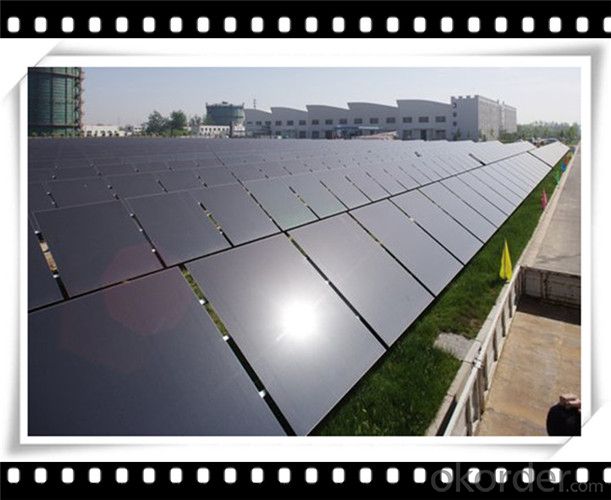
Specifications:
Tolerance | +/-3% |
Cell | Polycrystalline silicon solar cells (156 x 156mm) |
N0. of Cells | 60 (10 x 6) |
Dimension of Modules (mm) | 1650 x 990 x 40 |
Weight (kg) | 25.5 |
Limits:
Operating Temperature | -40~+85? |
Storage Temperature | -40~+85? |
Maximum System Voltage | 1000 VDC max. |
Hail Impact | Diameter of 28mm with impact speed |
Temperature and Coefficients:
NOCT | 48C+/-2? |
Voltage temperature coefficient (%/K) | -0.35 |
Current temperature coefficient (%/K) | 0.05 |
Power temperature coefficient (%/K) | -0.45 |
Characteristics:
Model: | SGM-200P | SGM-210P | SGM-220P |
Max-power voltage Vmp (V) | 29.2 | 29.4 | 29.41 |
Max-power current Imp (A) | 6.85 | 7.14 | 7.48 |
Open-circuit voltage Voc (V) | 36.5 | 36.69 | 36.9 |
Short-Circuit Current Isc (A) | 7.28 | 7.6 | 7.93 |
Max-power Pm(W) | 200 | 210 | 220 |
Model: | SGM-230P |
Max-power voltage Vmp (V) | 29.8 |
Max-power current Imp (A) | 7.72 |
Open-circuit voltage Voc (V) | 37.31 |
Short-Circuit Current Isc (A) | 8.19 |
Max-power Pm(W) | 230 |
STC: Irradiance 1000W/m2, module temperature 25?, AM-=1.5
Poly Crystalline Solar Panels Specifications Range
Maximum Power (Pm) | Dimension | Weight | Operating Voltage (Vmp) | Operating Current (Imp) | Open Circuit Voltage (Voc) | Short Circuit Current (Isc) |
0.45W | 140x80x10mm | 0.08kg | 3.3V | 150mA | 4.6V | 160mA |
1.0W | 162x140x10mm | 0.16kg | 7.5V | 150mA | 10.3V | 160mA |
4.5W | 269x251x23mm | 0.8kg | 16.5V | 0.27A | 20.5V | 0.3A |
10W | 420.1×268.9×22.6mm | 1.92kg | 17.5V | 0.58A | 20.5V | 0.6A |
20W | 425x502x50mm | 3.0kg | 16.8V | 1.19A | 21.0V | 1.29A |
30W | 593x502x22.6mm | 3.9kg | 16.8V | 1.78A | 21.0V | 1.94A |
40W | 655x537x50mm | 5.75kg | 17.3V | 2.31A | 22.1V | 2.54A |
50W | 839x537x50mm | 6.0kg | 17.5V | 2.9A | 21.8V | 3.17A |
65W | 1111x502x50mm | 7.2kg | 17.6V | 3.69A | 22.1V | 3.99A |
80W | 1204x537x50mm | 7.7kg | 17.6V | 4.55A | 22.1V | 4.8A |
- Q: Can solar panels be installed on a data center or technology facility?
- Yes, solar panels can be installed on a data center or technology facility. In fact, many data centers and technology facilities around the world have already adopted solar energy as a means of powering their operations. Solar panels can be installed on rooftops, parking lots, or nearby land to generate clean and renewable electricity, reducing the facility's reliance on traditional power sources and lowering its carbon footprint. This not only helps in reducing energy costs but also contributes to a more sustainable and environmentally friendly operation.
- Q: i hav e a project for school we need to calculate cost to buy and install solar panels in our school
- to okorder / you should really be able make report with this informatin. So for your school it would cost millions, you need to figure out how many kilowatts your school use, then use the information above to calculate how large of system would be required you will be very impressive and the most informed person in your school.
- Q: Can solar panels be used for powering a concert venue or entertainment center?
- Yes, solar panels can be used to power a concert venue or entertainment center. Solar energy can be harnessed through panels and converted into electricity, which can then be used to power various aspects of the venue, such as lighting, sound systems, and equipment. By utilizing solar panels, these venues can reduce their carbon footprint and potentially save on energy costs in the long run.
- Q: Can solar panels be installed on a mobile home?
- Yes, solar panels can be installed on a mobile home. In fact, mobile homes are an excellent candidate for solar panel installation due to their flexibility and relatively small energy demands. The panels can be mounted on the roof or on a ground-mounted system nearby, providing clean and renewable energy to power the home.
- Q: I have some property off the grid and am looking to add solar power
- Most Solar Panels are roughtly 6% efficient. Since the sun gives out about 366 watts per square meter, a good panel would be 200+ W/square meter. If you want to save a bunch of money, I suggest you have a look at this tutorial I'm linking. The guy explains how you can assemble your panel yourself. It's far easier than I first thought !
- Q: I have four power packs for solar lights. They have 3 AA .2volt batteries of 2450 mAh capacity installed in series for a total supply voltage of 4 volt maximum for the lights. I want to charge all four packs at once off a single 6 volt solar panel. With the four packs wired in parallel, what capacity output (wattage) panel do I need to charge the batteries in an 8 hour day?
- 3 cells in series makes a 3.6volt 2.4AH battery. You multiply the volts but not the capacity. In parallel would be .2volts, triple capacity. So 4 packs in parallel is 9.8AH. Rule of thumb for charging a flat battery is divide capacity by 0 for amps and charge for 5 hours. amp at 6 volts is doable, that would be 6 watts People who make batteries and solar cells usually over-rate them so I doubt that a solar panel of less than 20 watts rating will fully charge these batteries if they are flat. I'd google to see how you might control the charge current with a simple circuit.
- Q: i need someone to advice me which solar panels to buy.i have looked into few companies and i need some more info before decidingthe companies i checked were Sun tech trina solar Canadian solar and LDK solar.whice company should i pick?? please help.
- Are you talking about buying panels, or investing in stock? LDK does not make panels, they make solar grade silicon that goes into panels. I haven't heard bad buzz recently about any brand of panel. Therefore, I would go by price per watt alone. If you type in solar panel price into Google, you're sure to get directed to the major sellers, each of whom will sell many brands of panels. There are a couple other requirements that I would have for a serious system: ) Safety certification such as UL. This will be legally required for a grid-tied system. All panels except the really fly-by-night brands and factory seconds have this. 2) 25-year performance warranty. It's standard now for a manufacturer to guarantee that their panel will still produce 80% of the rated output after 25 years. Older panels may say 20 years. Junk panels will have no such warranty, or something ridiculous like 90 days or year. 3) Crystalline silicon. Monocrystalline or polycrystalline doesn't matter. Every few years, someone claims that they have an amorphous or thin-film technology that's durable. Being conservative, I'm still waiting for such things to be proven. Some crystalline panels have been in service since the 70's, although they are pitifully weak by today's standards. I've heard good things about the Sanyo HIT hybrid panels, but that's only from one person who had them installed.
- Q: i want to how i make solar panels
- For okorder /
- Q: if i was to put a solar panel (sp) just outside of the earths atmosphere ans another solar panel (sp2) 0km away towards the sun. which one would generate more power (sp or sp2)? and how much more? is there a ratio to work out the power output and distance from the sun? would the 0km distance between the panels make a large difference in power output?many thanks in advance
- Guide okorder /
- Q: Can solar panels be used in areas with high levels of noise from transportation?
- Yes, solar panels can be used in areas with high levels of noise from transportation. Noise pollution does not affect the functionality of solar panels as they primarily rely on sunlight to generate electricity. However, it's important to ensure that the panels are properly installed and maintained to maximize their efficiency and minimize any potential disruptions caused by noise pollution.
Send your message to us
70W Small Camping Solar Panels - Poly Solar Panel Manufacturer in China CNBM
- Loading Port:
- Qingdao
- Payment Terms:
- TT OR LC
- Min Order Qty:
- 10 set
- Supply Capability:
- 300000 set/month
OKorder Service Pledge
OKorder Financial Service
Similar products
Hot products
Hot Searches
Related keywords
